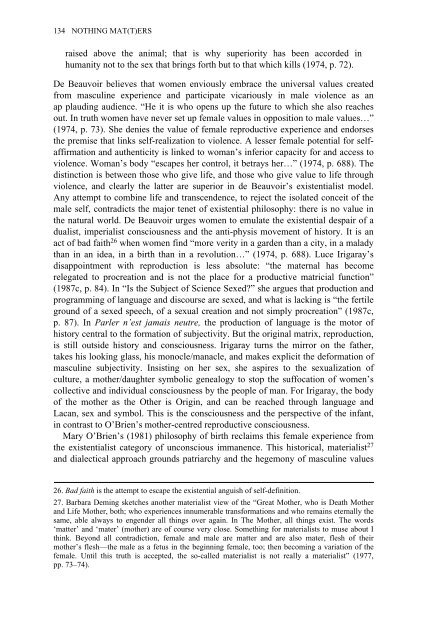Nothing Mat(t)ers: A Feminist Critique of Postmodernism
Nothing Mat(t)ers: A Feminist Critique of Postmodernism
Nothing Mat(t)ers: A Feminist Critique of Postmodernism
You also want an ePaper? Increase the reach of your titles
YUMPU automatically turns print PDFs into web optimized ePapers that Google loves.
134 NOTHING MAT(T)ERS<br />
raised above the animal; that is why superiority has been accorded in<br />
humanity not to the sex that brings forth but to that which kills (1974, p. 72).<br />
De Beauvoir believes that women enviously embrace the univ<strong>ers</strong>al values created<br />
from masculine experience and participate vicariously in male violence as an<br />
ap plauding audience. “He it is who opens up the future to which she also reaches<br />
out. In truth women have never set up female values in opposition to male values…”<br />
(1974, p. 73). She denies the value <strong>of</strong> female reproductive experience and endorses<br />
the premise that links self-realization to violence. A lesser female potential for selfaffirmation<br />
and authenticity is linked to woman’s inferior capacity for and access to<br />
violence. Woman’s body “escapes her control, it betrays her…” (1974, p. 688). The<br />
distinction is between those who give life, and those who give value to life through<br />
violence, and clearly the latter are superior in de Beauvoir’s existentialist model.<br />
Any attempt to combine life and transcendence, to reject the isolated conceit <strong>of</strong> the<br />
male self, contradicts the major tenet <strong>of</strong> existential philosophy: there is no value in<br />
the natural world. De Beauvoir urges women to emulate the existential despair <strong>of</strong> a<br />
dualist, imperialist consciousness and the anti-physis movement <strong>of</strong> history. It is an<br />
act <strong>of</strong> bad faith 26 when women find “more verity in a garden than a city, in a malady<br />
than in an idea, in a birth than in a revolution…” (1974, p. 688). Luce Irigaray’s<br />
disappointment with reproduction is less absolute: “the maternal has become<br />
relegated to procreation and is not the place for a productive matricial function”<br />
(1987c, p. 84). In “Is the Subject <strong>of</strong> Science Sexed” she argues that production and<br />
programming <strong>of</strong> language and discourse are sexed, and what is lacking is “the fertile<br />
ground <strong>of</strong> a sexed speech, <strong>of</strong> a sexual creation and not simply procreation” (1987c,<br />
p. 87). In Parler n’est jamais neutre, the production <strong>of</strong> language is the motor <strong>of</strong><br />
history central to the formation <strong>of</strong> subjectivity. But the original matrix, reproduction,<br />
is still outside history and consciousness. Irigaray turns the mirror on the father,<br />
takes his looking glass, his monocle/manacle, and makes explicit the deformation <strong>of</strong><br />
masculine subjectivity. Insisting on her sex, she aspires to the sexualization <strong>of</strong><br />
culture, a mother/daughter symbolic genealogy to stop the suffocation <strong>of</strong> women’s<br />
collective and individual consciousness by the people <strong>of</strong> man. For Irigaray, the body<br />
<strong>of</strong> the mother as the Other is Origin, and can be reached through language and<br />
Lacan, sex and symbol. This is the consciousness and the p<strong>ers</strong>pective <strong>of</strong> the infant,<br />
in contrast to O’Brien’s mother-centred reproductive consciousness.<br />
Mary O’Brien’s (1981) philosophy <strong>of</strong> birth reclaims this female experience from<br />
the existentialist category <strong>of</strong> unconscious immanence. This historical, materialist 27<br />
and dialectical approach grounds patriarchy and the hegemony <strong>of</strong> masculine values<br />
26. Bad faith is the attempt to escape the existential anguish <strong>of</strong> self-definition.<br />
27. Barbara Deming sketches another materialist view <strong>of</strong> the “Great Mother, who is Death Mother<br />
and Life Mother, both; who experiences innumerable transformations and who remains eternally the<br />
same, able always to engender all things over again. In The Mother, all things exist. The words<br />
‘matter’ and ‘mater’ (mother) are <strong>of</strong> course very close. Something for materialists to muse about I<br />
think. Beyond all contradiction, female and male are matter and are also mater, flesh <strong>of</strong> their<br />
mother’s flesh—the male as a fetus in the beginning female, too; then becoming a variation <strong>of</strong> the<br />
female. Until this truth is accepted, the so-called materialist is not really a materialist” (1977,<br />
pp. 73–74).

















